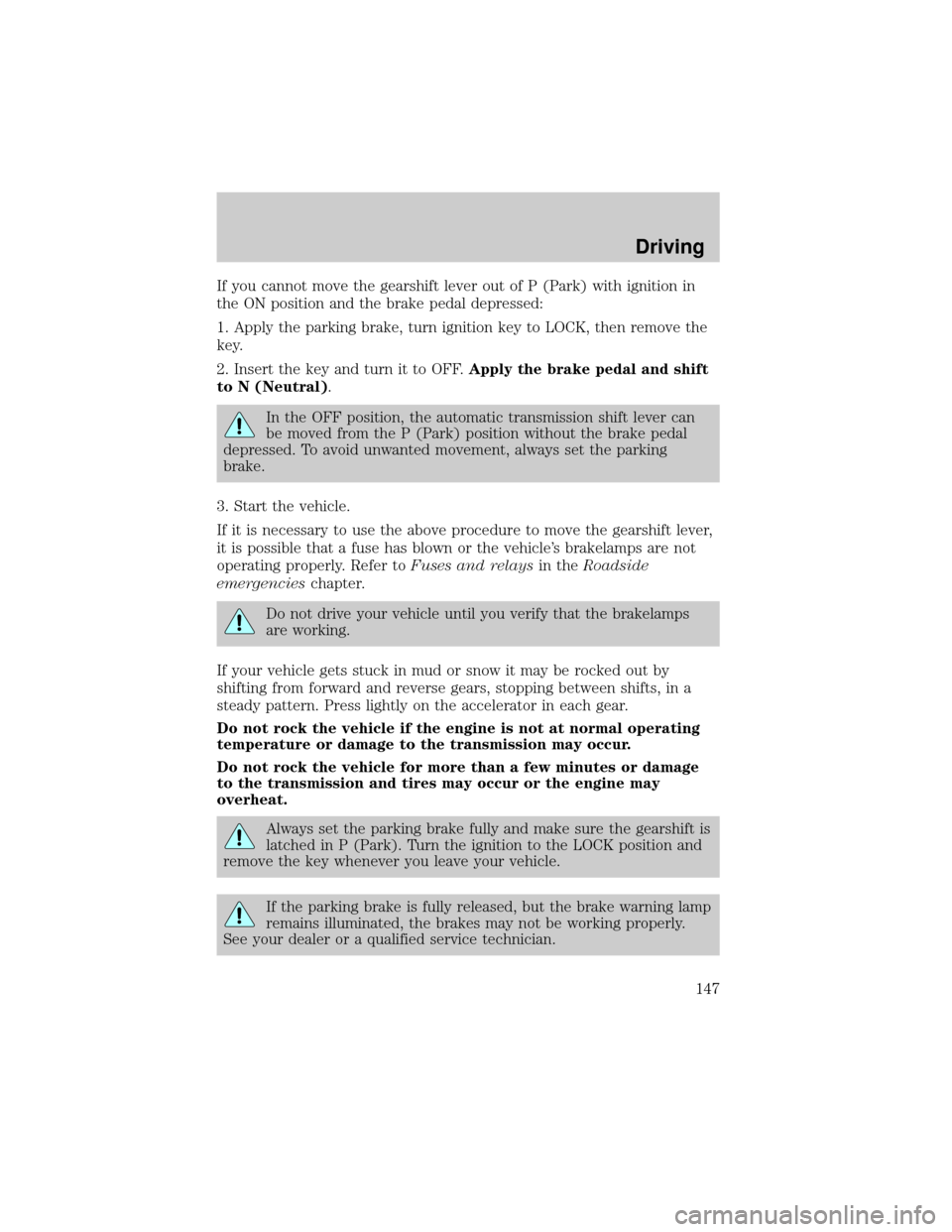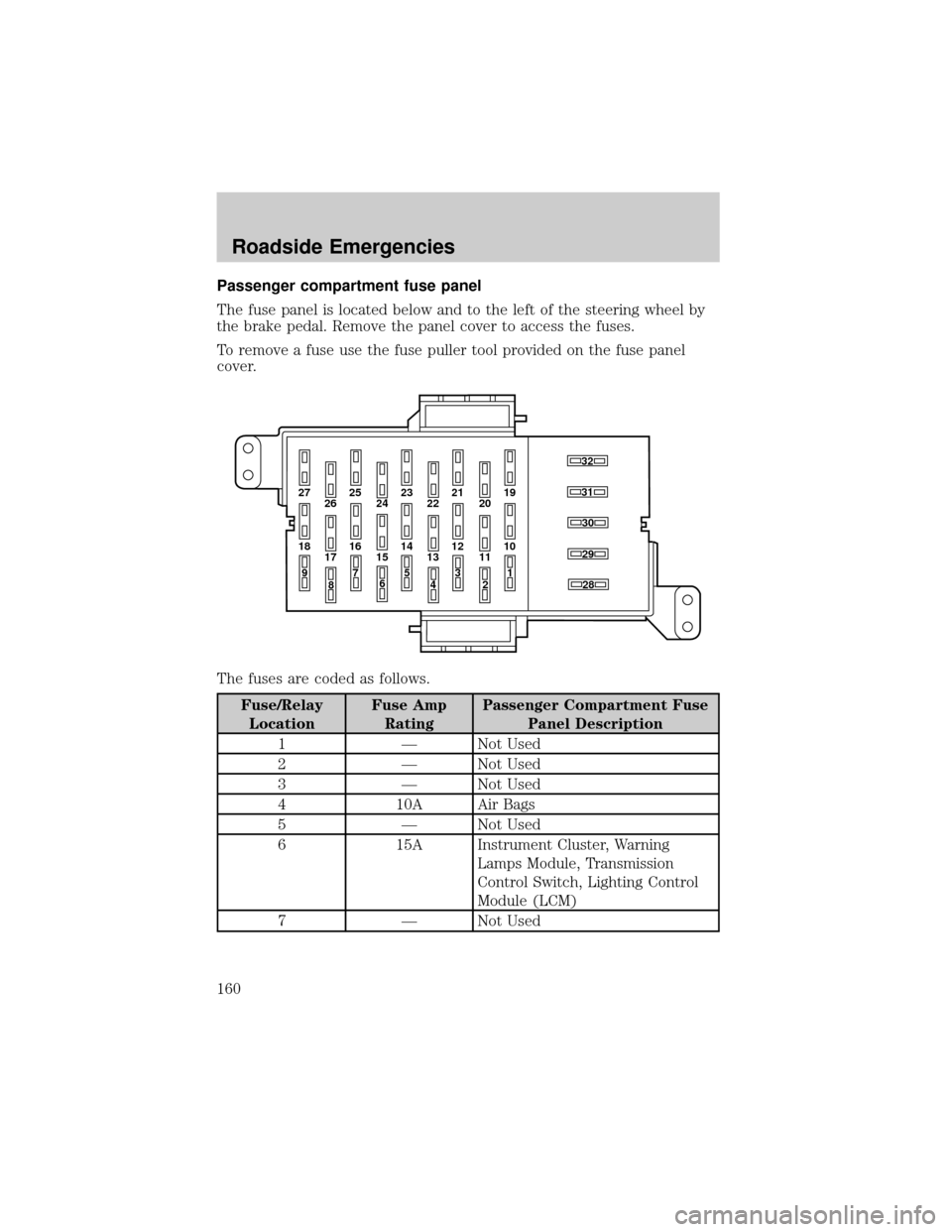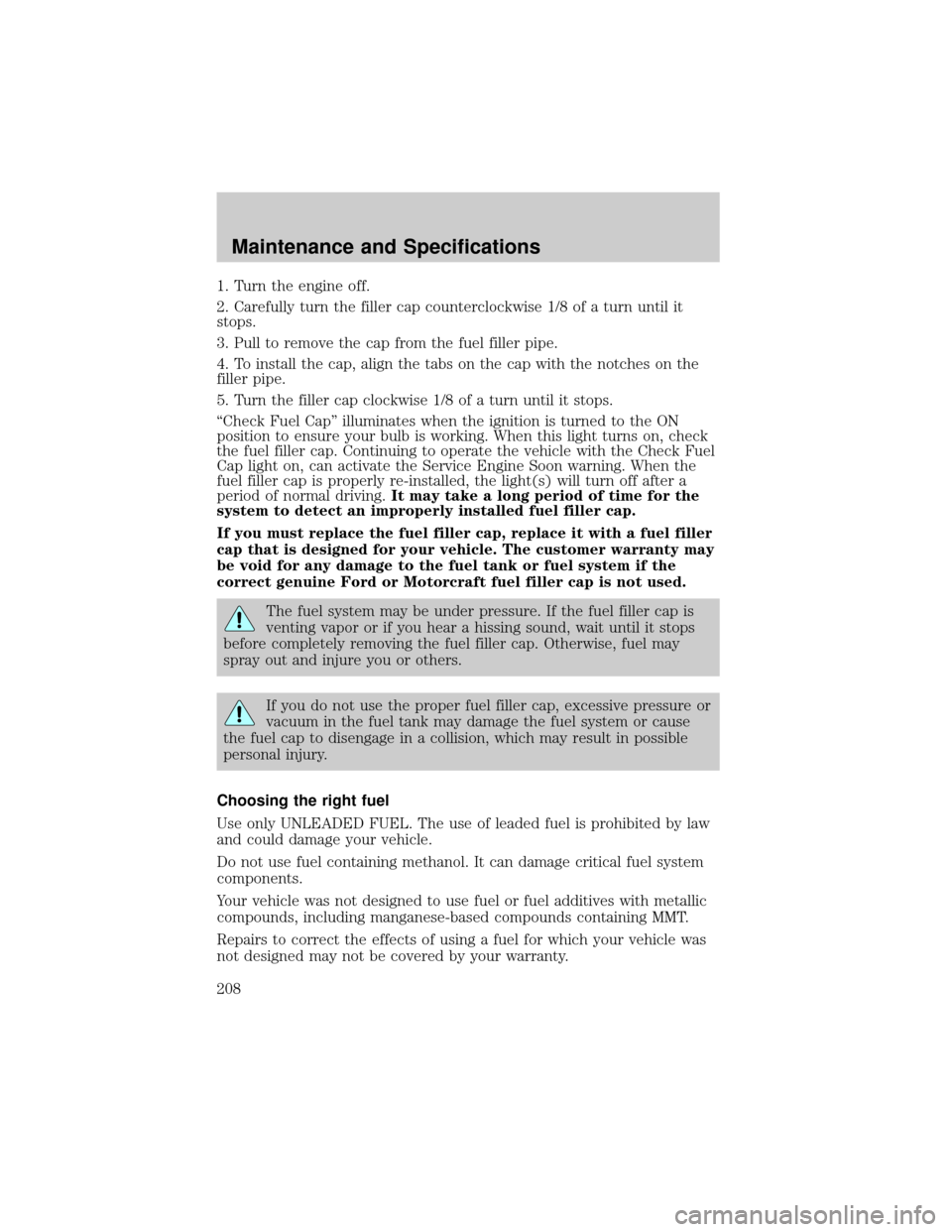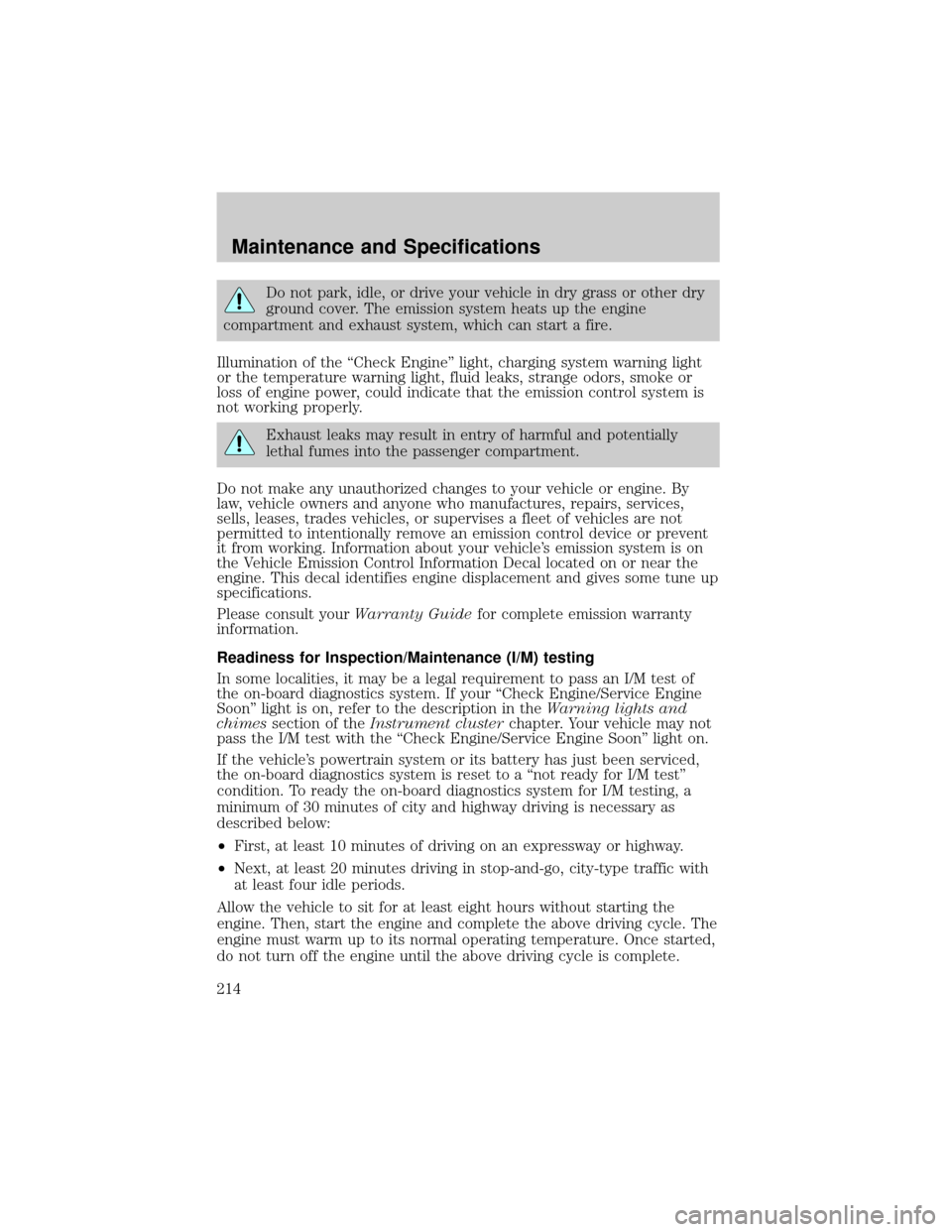2002 FORD CROWN VICTORIA warning light
[x] Cancel search: warning lightPage 147 of 240

If you cannot move the gearshift lever out of P (Park) with ignition in
the ON position and the brake pedal depressed:
1. Apply the parking brake, turn ignition key to LOCK, then remove the
key.
2. Insert the key and turn it to OFF.Apply the brake pedal and shift
to N (Neutral).
In the OFF position, the automatic transmission shift lever can
be moved from the P (Park) position without the brake pedal
depressed. To avoid unwanted movement, always set the parking
brake.
3. Start the vehicle.
If it is necessary to use the above procedure to move the gearshift lever,
it is possible that a fuse has blown or the vehicle's brakelamps are not
operating properly. Refer toFuses and relaysin theRoadside
emergencieschapter.
Do not drive your vehicle until you verify that the brakelamps
are working.
If your vehicle gets stuck in mud or snow it may be rocked out by
shifting from forward and reverse gears, stopping between shifts, in a
steady pattern. Press lightly on the accelerator in each gear.
Do not rock the vehicle if the engine is not at normal operating
temperature or damage to the transmission may occur.
Do not rock the vehicle for more than a few minutes or damage
to the transmission and tires may occur or the engine may
overheat.
Always set the parking brake fully and make sure the gearshift is
latched in P (Park). Turn the ignition to the LOCK position and
remove the key whenever you leave your vehicle.
If the parking brake is fully released, but the brake warning lamp
remains illuminated, the brakes may not be working properly.
See your dealer or a qualified service technician.
Driving
147
Page 160 of 240

Passenger compartment fuse panel
The fuse panel is located below and to the left of the steering wheel by
the brake pedal. Remove the panel cover to access the fuses.
To remove a fuse use the fuse puller tool provided on the fuse panel
cover.
The fuses are coded as follows.
Fuse/Relay
LocationFuse Amp
RatingPassenger Compartment Fuse
Panel Description
1 Ð Not Used
2 Ð Not Used
3 Ð Not Used
4 10A Air Bags
5 Ð Not Used
6 15A Instrument Cluster, Warning
Lamps Module, Transmission
Control Switch, Lighting Control
Module (LCM)
7 Ð Not Used
27 25
26 2423 21
2219
20
18 16
17 1514 12
131030
32
31
28
29
11
97
8653
41
2
Roadside Emergencies
160
Page 208 of 240

1. Turn the engine off.
2. Carefully turn the filler cap counterclockwise 1/8 of a turn until it
stops.
3. Pull to remove the cap from the fuel filler pipe.
4. To install the cap, align the tabs on the cap with the notches on the
filler pipe.
5. Turn the filler cap clockwise 1/8 of a turn until it stops.
ªCheck Fuel Capº illuminates when the ignition is turned to the ON
position to ensure your bulb is working. When this light turns on, check
the fuel filler cap. Continuing to operate the vehicle with the Check Fuel
Cap light on, can activate the Service Engine Soon warning. When the
fuel filler cap is properly re-installed, the light(s) will turn off after a
period of normal driving.It may take a long period of time for the
system to detect an improperly installed fuel filler cap.
If you must replace the fuel filler cap, replace it with a fuel filler
cap that is designed for your vehicle. The customer warranty may
be void for any damage to the fuel tank or fuel system if the
correct genuine Ford or Motorcraft fuel filler cap is not used.
The fuel system may be under pressure. If the fuel filler cap is
venting vapor or if you hear a hissing sound, wait until it stops
before completely removing the fuel filler cap. Otherwise, fuel may
spray out and injure you or others.
If you do not use the proper fuel filler cap, excessive pressure or
vacuum in the fuel tank may damage the fuel system or cause
the fuel cap to disengage in a collision, which may result in possible
personal injury.
Choosing the right fuel
Use only UNLEADED FUEL. The use of leaded fuel is prohibited by law
and could damage your vehicle.
Do not use fuel containing methanol. It can damage critical fuel system
components.
Your vehicle was not designed to use fuel or fuel additives with metallic
compounds, including manganese-based compounds containing MMT.
Repairs to correct the effects of using a fuel for which your vehicle was
not designed may not be covered by your warranty.
Maintenance and Specifications
208
Page 214 of 240

Do not park, idle, or drive your vehicle in dry grass or other dry
ground cover. The emission system heats up the engine
compartment and exhaust system, which can start a fire.
Illumination of the ªCheck Engineº light, charging system warning light
or the temperature warning light, fluid leaks, strange odors, smoke or
loss of engine power, could indicate that the emission control system is
not working properly.
Exhaust leaks may result in entry of harmful and potentially
lethal fumes into the passenger compartment.
Do not make any unauthorized changes to your vehicle or engine. By
law, vehicle owners and anyone who manufactures, repairs, services,
sells, leases, trades vehicles, or supervises a fleet of vehicles are not
permitted to intentionally remove an emission control device or prevent
it from working. Information about your vehicle's emission system is on
the Vehicle Emission Control Information Decal located on or near the
engine. This decal identifies engine displacement and gives some tune up
specifications.
Please consult yourWarranty Guidefor complete emission warranty
information.
Readiness for Inspection/Maintenance (I/M) testing
In some localities, it may be a legal requirement to pass an I/M test of
the on-board diagnostics system. If your ªCheck Engine/Service Engine
Soonº light is on, refer to the description in theWarning lights and
chimessection of theInstrument clusterchapter. Your vehicle may not
pass the I/M test with the ªCheck Engine/Service Engine Soonº light on.
If the vehicle's powertrain system or its battery has just been serviced,
the on-board diagnostics system is reset to a ªnot ready for I/M testº
condition. To ready the on-board diagnostics system for I/M testing, a
minimum of 30 minutes of city and highway driving is necessary as
described below:
²First, at least 10 minutes of driving on an expressway or highway.
²Next, at least 20 minutes driving in stop-and-go, city-type traffic with
at least four idle periods.
Allow the vehicle to sit for at least eight hours without starting the
engine. Then, start the engine and complete the above driving cycle. The
engine must warm up to its normal operating temperature. Once started,
do not turn off the engine until the above driving cycle is complete.
Maintenance and Specifications
214
Page 233 of 240

A
ABS (see Brakes) .....................142
Air bag supplemental restraint
system ................................122±123
and child safety seats ............124
description ..............................123
disposal ....................................127
driver air bag ..........................125
indicator light ...................13, 126
operation .................................125
passenger air bag ...................125
Air cleaner filter ...............219, 224
Air conditioning ..........................56
manual heating and air
conditioning system .................54
Air suspension ...........................146
description ..............................146
warning light .............................14
Antifreeze (see Engine
coolant) .....................................199
Anti-lock brake system
(see Brakes) ..............................142
Audio system (see Radio) .........26
Automatic transmission
driving an automatic
overdrive .................................148
fluid, adding ............................216
fluid, checking ........................216
fluid, refill capacities ..............225
fluid, specification ..................228
Auxiliary power point .................74
Axle
lubricant specifications ..226, 228
refill capacities ........................225
traction lok ..............................150B
Battery .......................................197
acid, treating emergencies .....197
charging system warning light 13
jumping a disabled battery ....169
maintenance-free ....................197
replacement, specifications ...224
servicing ..................................197
voltage gauge ............................19
BeltMinder .................................118
Brakes ........................................141
anti-lock ...................................142
anti-lock brake system (ABS)
warning light .....................12, 143
brake warning light ..................12
fluid, checking and adding ....216
fluid, refill capacities ..............225
fluid, specifications .........226, 228
lubricant specifications ..226, 228
pedals (see Power adjustable
foot pedals) ...............................78
shift interlock ..........................146
Break-in period .............................5
Bulbs ............................................65
C
Capacities for refilling fluids ....225
Cassette tape player ...................39
CD changer .................................49
CD-single .....................................33
Certification Label ....................229
Changing a tire .........................164
Child safety restraints ..............127
Index
233
Page 235 of 240

cleaning ...................................186
coolant .....................................199
fail-safe coolant ......................204
idle speed control ...................197
lubrication specifications ......226,
228
refill capacities ........................225
service points ..........................192
starting after a collision .........158
Engine block heater .................140
Engine oil ..................................193
change oil soon warning,
message center .......................193
checking and adding ..............193
dipstick ....................................193
filter, specifications ........196, 224
recommendations ...................196
refill capacities ........................225
specifications ..................226, 228
Exhaust fumes ..........................140
F
Fail safe cooling ........................204
Floor mats ...................................90
Fluid capacities .........................225
Fuel ............................................206
calculating fuel economy .......210
cap .....................................11, 207
capacity ...................................225
choosing the right fuel ...........208
comparisons with EPA fuel
economy estimates .................213
detergent in fuel .....................209
filling your vehicle with
fuel ...........................206±207, 210
filter, specifications ........210, 224
fuel filler door override ............89
fuel filler door release ..............88
fuel pump shut-off switch .....158gauge .........................................19
improving fuel economy ........210
low fuel warning light ..............14
octane rating ...................209, 228
quality ......................................209
running out of fuel .................210
safety information relating to
automotive fuels .....................206
Fuses ..................................159±160
G
Gas cap (see Fuel cap) ......11, 207
Gas mileage (see Fuel
economy) ...................................210
Gauges .........................................17
battery voltage gauge ...............19
engine coolant temperature
gauge .........................................17
engine oil pressure gauge ........18
fuel gauge ..................................19
odometer ...................................20
speedometer .............................20
trip odometer ............................21
GAWR (Gross Axle Weight
Rating) .......................................151
definition .................................151
driving with a heavy load ......151
location ....................................151
GVWR (Gross Vehicle Weight
Rating) .......................................151
calculating ...............................151
definition .................................151
driving with a heavy load ......151
location ....................................151
H
Hazard flashers .........................157
Head restraints .........................104
Index
235
Page 236 of 240

Headlamps ...................................63
aiming ........................................65
autolamp system .......................63
bulb specifications ....................66
daytime running lights .............63
flash to pass ..............................64
high beam ...........................15, 64
replacing bulbs .........................67
turning on and off ....................63
warning chime ..........................16
Heating
heating and air conditioning
system .................................54, 56
Hood ..........................................192
I
Ignition ...............................137, 228
Infant seats
(see Safety seats) .....................130
Inspection/maintenance (I/M)
testing ........................................214
Instrument panel
cleaning ...................................188
cluster ................................10, 188
lighting up panel and
interior .......................................64
J
Jack ............................................164
positioning ...............................164
storage .....................................164
Jump-starting your vehicle ......169
K
Keyless entry system .................98
autolock .....................................97
keypad .......................................98programming entry code .........99
Keys ...................................100±102
key in ignition chime ...............16
positions of the ignition .........137
L
Lamps
autolamp system .......................63
bulb replacement
specifications chart ..................66
cargo lamps ...............................64
daytime running light ...............63
headlamps .................................63
headlamps, flash to pass ..........64
instrument panel, dimming .....64
interior lamps ...............63, 65, 67
replacing bulbs .............65, 67±71
Lane change indicator
(see Turn signal) ........................65
Lights, warning and indicator ....10
air bag ........................................13
air suspension ...........................14
anti-lock brakes (ABS) ....12, 143
brake ..........................................12
charging system ........................13
check engine .............................10
fuel cap light .............................11
high beam .................................15
low coolant ................................13
low fuel ......................................14
oil pressure ...............................13
overdrive off ..............................14
safety belt .................................13
speed control ............................82
traction control active ..............14
turn signal indicator .................15
Limited slip axle (see Traction
Loc) ............................................150
Load limits .................................151
GAWR ......................................151
Index
236
Page 238 of 240

cleaning the safety
belts .................................122, 189
extension assembly ................121
for adults .........................113±115
for children .............................127
lap belt ....................................116
Occupant Classification
Sensor ......................................110
warning light and
chime ...................13, 16, 117±118
Safety seats for children ..........130
Seat belts (see Safety
restraints) ..................................108
Seats ..........................................104
child safety seats ....................130
cleaning ...................................188
SecuriLock passive anti-theft
system ................................100±102
Servicing your vehicle ..............191
Spare tire (see Changing the
Tire) ...........................................164
Spark plugs,
specifications .....................224, 228
Specification chart,
lubricants ...........................226, 228
Speed control ..............................79
Speedometer ...............................20
Starting your vehicle ........137±139
jump starting ..........................169
Steering
speed sensitive .......................146
Steering wheel
controls ..........................73, 79, 83
tilting .........................................73T
Tires ...........................164, 220±221
changing ..........................164±165
checking the pressure ............221
replacing ..................................223
rotating ....................................221
snow tires and chains ............224
tire grades ...............................221
treadwear ................................220
Towing .......................................152
recreational towing .................155
trailer towing ..........................152
wrecker ....................................174
Traction control ........................144
active light ................................14
Traction-lok rear axle ...............150
Transmission .............................146
fluid, checking and adding
(automatic) .............................216
fluid, refill capacities ..............225
lubricant specifications ..226, 228
Trip odometer .............................21
Trunk ...........................................92
remote release ....................89, 95
Turn signal ............................15, 65
V
Vehicle dimensions ...................228
Vehicle Identification Number
(VIN) ..........................................230
Vehicle loading ..........................151
Ventilating your vehicle ...........141
Index
238